Mountain Pose (Tadasana)
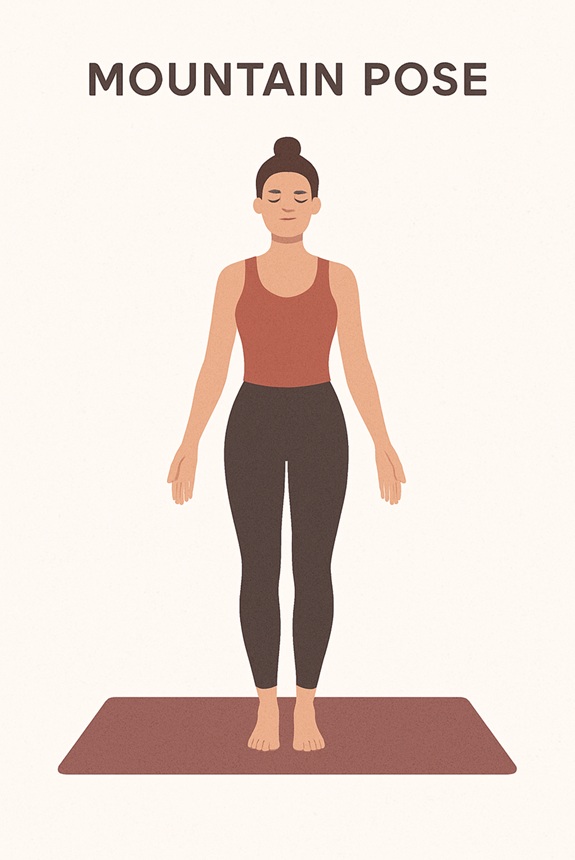
Tadasana, or Mountain Pose, is the foundational standing posture in yoga. It represents stability, groundedness, and alignment, serving as the starting point for many other standing poses.
Description & Steps:
- Stand with feet hip-width apart or together, grounding all four corners of each foot.
- Engage the thighs slightly and lift the kneecaps.
- Draw the tailbone gently down and lengthen the spine.
- Relax the shoulders, letting arms hang naturally by the sides, palms facing inward or forward.
- Keep the gaze forward, chin slightly tucked, breathing naturally.
Benefits:
- Improves posture and spinal alignment.
- Strengthens legs, core, and ankles.
- Enhances body awareness and balance.
Contraindications:
- Severe dizziness or vertigo (stand near a wall for support).
- Recent leg, ankle, or foot injury.
- Low blood pressure that causes lightheadedness when standing long.
Child’s Pose (Balasana)

Balasana, or Child’s Pose, is a resting posture in yoga used to calm the mind, gently stretch the spine, and restore energy. It symbolizes surrender and introspection.
Description & Steps:
- Kneel on the mat, touch the big toes together, and sit back on your heels.
- Separate the knees about hip-width apart.
- Fold forward, extending arms in front or resting them alongside the body.
- Rest the forehead on the mat and relax the neck.
- Close the eyes and breathe deeply, letting the torso soften over the thighs.
Benefits:
- Relieves tension in the back, shoulders, and neck.
- Reduces stress and fatigue.
- Gently stretches hips, thighs, and spine.
- Contraindications:
- Knee injuries (use a cushion or avoid deep folding).
- Pregnancy (especially in later trimesters, use wide knees or skip).
- Severe ankle problems (cushion under feet may help).
Savasana (Corpse Pose)

Savasana, or Corpse Pose, is a final relaxation posture in yoga designed for deep physical and mental relaxation, integration, and rejuvenation.
Description & Steps:
- Lie flat on your back with legs slightly apart and feet relaxed outward.
- Let the arms rest alongside the body, palms facing up.
- Close your eyes and release all tension in the body.
- Focus on the natural rhythm of the breath, allowing the mind to settle.
- Remain in the pose for 5–10 minutes or longer.
Benefits:
- Promotes deep relaxation and mental clarity.
- Reduces stress, anxiety, and blood pressure.
- Restores energy and integrates the benefits of the yoga practice.
Contraindications:
- Severe lower back pain (use bolster under knees).
- Sleep disorders if practice leads to drowsiness at an unsafe time.
- Respiratory issues that require upright posture for comfort.
Cat-Cow Pose (Marjaryasana-Bitilasana)
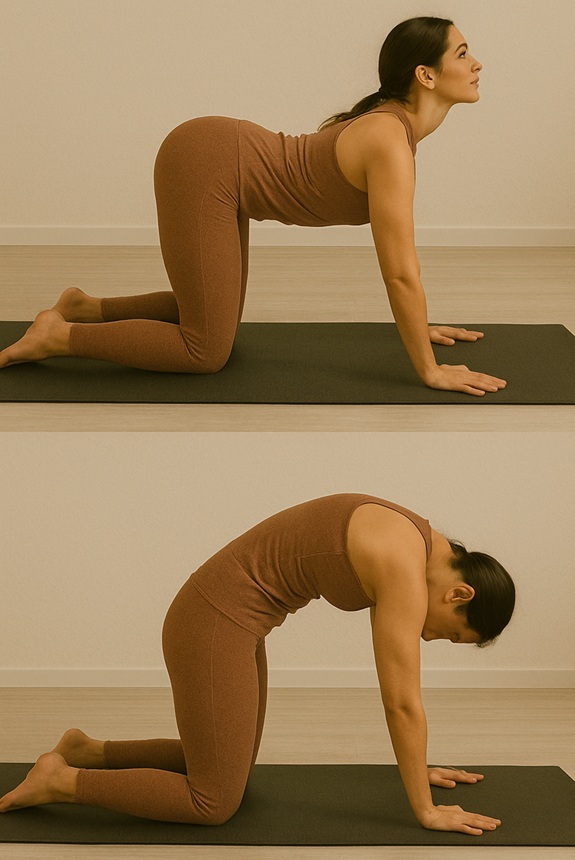
Cat-Cow is a dynamic, flowing spinal movement used to warm up the spine, improve flexibility, and connect breath with movement. It balances mobility and stability in the back.
Description & Steps:
- Start on hands and knees in a tabletop position, wrists under shoulders, knees under hips.
- Cow Pose (inhale): Drop the belly toward the mat, lift the chest and tailbone upward, and gaze slightly forward.
- Cat Pose (exhale): Round the spine upward, tuck the chin to the chest, and draw the navel in.
- Flow slowly between the two movements with each inhale and exhale.
- Repeat for 8–10 rounds, breathing deeply and evenly.
Benefits:
- Increases spinal flexibility and mobility.
- Massages and stimulates abdominal organs.
- Relieves tension in the neck, back, and shoulders.
Contraindications:
- Recent spinal injury or severe back pain.
- Wrist issues or carpal tunnel syndrome (use fists or props).
- Pregnancy in later stages (avoid deep arching).
Bridge Pose (Setu Bandhasana)

Setu Bandhasana, or Bridge Pose, is a backbend posture that opens the chest, strengthens the lower back, and improves circulation.
Description & Steps:
- Lie on your back with knees bent, feet hip-width apart, and arms alongside your body.
- Press the feet and arms into the mat and lift the hips toward the ceiling.
- Roll the shoulders slightly under, keeping the chest open.
- Maintain the pose for 20–30 seconds, breathing deeply.
- Lower the hips slowly on an exhale to release.
Benefits:
- Strengthens glutes, lower back, and hamstrings.
- Opens the chest and shoulders.
- Improves circulation and relieves mild depression and stress.
Contraindications:
- Neck injury (avoid pressing neck into the floor).
- Severe lower back pain or spinal issues.
- Recent knee or hip surgery (practice with caution).
Bhujangasana (Cobra Pose)

Bhujangasana, or Cobra Pose, is a gentle backbend that strengthens the spine, opens the chest, and stimulates abdominal organs.
Description & Steps:
- Lie on your stomach, legs extended, tops of feet pressing into the mat.
- Place palms under shoulders, elbows close to the body.
- Inhale and gently lift the chest off the floor, using the back muscles more than the hands.
- Keep shoulders relaxed, gaze forward or slightly upward.
- Hold for 15–30 seconds, then exhale and lower down slowly.
Benefits:
- Strengthens the spine and back muscles.
- Opens the chest and lungs for better breathing.
- Stimulates abdominal organs and relieves fatigue.
Contraindications:
- Severe lower back injury or herniated disc.
- Pregnancy (especially after the first trimester).
- Carpal tunnel or wrist injury (use forearms or avoid deep backbend).
Fish Pose (Matsyasana)

Matsyasana, or Fish Pose, is a chest-opening backbend that stretches the throat, lungs, and abdomen, often counterbalancing forward bends.
Description & Steps:
- Lie on your back with legs extended and arms alongside your body.
- Press elbows and forearms into the floor, lift the chest, and gently arch the back.
- Tilt the head back so the crown lightly touches the mat (use a folded blanket or block if needed).
- Keep legs engaged and breathe deeply, maintaining the pose for 20–30 seconds.
- Slowly release by lowering the chest and head to the floor.
Benefits:
- Opens chest, throat, and shoulders.
- Strengthens upper back and neck muscles.
- Improves respiratory function and relieves mild tension in the spine.
Contraindications:
- Neck or upper back injury.
- Severe shoulder or spine issues.
- High blood pressure or heart problems (avoid deep backbend without supervision).
Warrior II (Virabhadrasana II)

Warrior II is a standing strength and balance posture that opens the hips and chest while building stamina and focus.
Description & Steps:
- Step one foot back about 3–4 feet, turning it slightly outward.
- Bend the front knee so it’s directly above the ankle; keep the back leg straight.
- Extend arms parallel to the floor, shoulders relaxed, palms facing down.
- Gaze over the front hand and hold for 20–30 seconds.
- Switch sides.
Benefits:
- Strengthens legs, hips, and core.
- Improves balance and concentration.
- Opens chest and shoulders, enhancing posture.
Contraindications:
- Knee, ankle, or hip injury (use support or skip).
- Low blood pressure causing dizziness when holding long.
- Recent leg surgery or muscle strain.
Tree Pose (Vrikshasana)
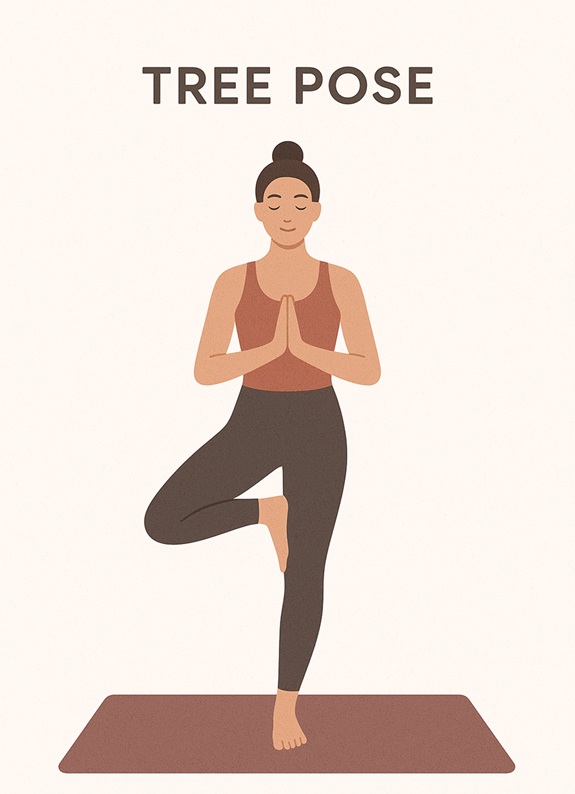
Tree Pose is a balance and grounding posture that promotes stability, focus, and inner calm.
Description & Steps:
- Stand tall in Mountain Pose.
- Shift weight onto one leg, bending the other knee and placing the foot on inner thigh or calf (avoid the knee).
- Press palms together at the chest (Anjali Mudra) or overhead.
- Focus gaze on a fixed point (drishti) and hold for 20–30 seconds.
- Switch sides.
Benefits:
- Improves balance and coordination.
- Strengthens legs, ankles, and core.
- Enhances focus, calm, and mental stability.
Contraindications:
- Severe ankle, knee, or hip problems (use wall support).
- Vertigo or balance disorders (practice near a wall).
- Recent leg injury preventing weight-bearing.
Seated Spinal Twist (Ardha Matsyendrasana)

Seated Spinal Twist is a gentle twisting posture that improves spinal flexibility and aids digestion.
Description & Steps:
- Sit tall with legs extended.
- Bend one knee and place the foot outside the opposite thigh.
- Place opposite elbow outside the bent knee, spine straight, shoulders relaxed.
- Twist gently toward the bent knee, lengthening through the crown of the head.
- Hold for 20–30 seconds, then switch sides.
Benefits:
- Increases spinal flexibility.
- Stimulates digestion and detoxification.
- Relieves tension in the back and shoulders.
Contraindications:
- Herniated disc or severe spinal injury.
- Recent abdominal surgery.
- Pregnancy (avoid deep twists).
Standing Forward Fold (Uttanasana)
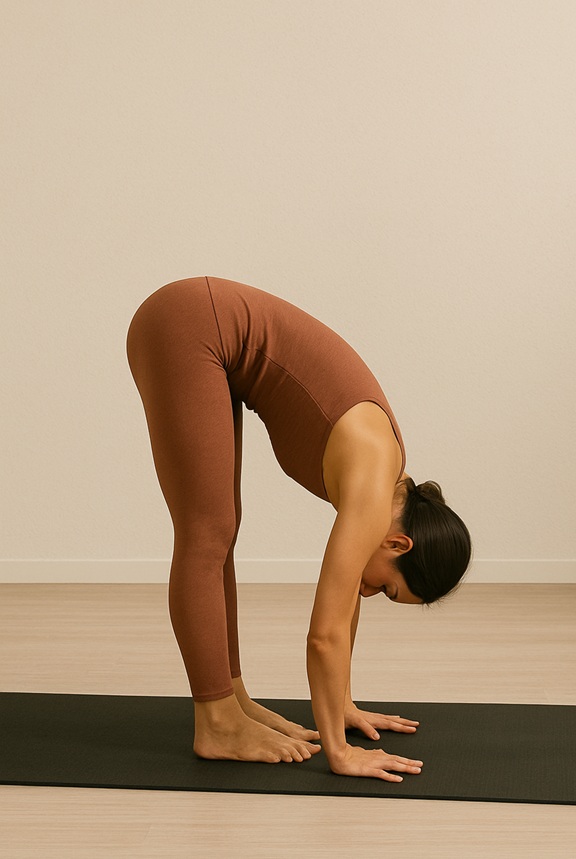
Uttanasana is a forward-bending posture that stretches the hamstrings and spine while calming the nervous system.
Description & Steps:
- Stand tall in Mountain Pose.
- Exhale and hinge at the hips to fold forward, keeping spine long.
- Let the head hang naturally and arms rest toward the floor or hold elbows.
- Relax the neck and shoulders, breathing deeply for 20–30 seconds.
Benefits:
- Stretches hamstrings, calves, and spine.
- Relieves stress and mild anxiety.
- Improves circulation to the brain, increasing calmness.
Contraindications:
- Severe back or neck injury.
- High blood pressure (fold slightly or support head).
- Glaucoma or eye problems (avoid full inversion
Seated Forward Fold (Paschimottanasana)

Paschimottanasana is a seated forward bend that stretches the entire back body and promotes introspection.
Description & Steps:
- Sit tall with legs extended forward, spine straight.
- Inhale, raise arms overhead.
- Exhale and hinge from the hips, reaching toward the feet, ankles, or shins.
- Keep the spine long, relaxing the head and neck.
- Hold for 30–60 seconds, breathing deeply.
Benefits:
- Stretches spine, hamstrings, and calves.
- Calms the mind and reduces anxiety.
- Stimulates abdominal organs and improves digestion.
Contraindications:
- Herniated disc or severe lower back issues.
- Hamstring or knee injuries.
- Pregnancy (avoid deep forward folding).
Supine Spinal Twist (Supta Matsyendrasana)

Supine Spinal Twist is a reclining twist that relaxes the spine, stretches the back muscles, and promotes spinal mobility.
Description & Steps:
- Lie on your back with knees bent and feet flat on the mat.
- Drop both knees to one side while keeping shoulders grounded.
- Extend arms in a T-shape, turn the head gently toward the opposite side.
- Breathe deeply and hold for 30–60 seconds, then switch sides.
Benefits:
- Relieves tension in the lower back and spine.
- Improves spinal flexibility and alignment.
- Massages abdominal organs and supports digestion.
Contraindications:
- Severe spinal injury or herniated discs.
- Recent abdominal surgery.
- Pregnancy (avoid deep twists; modify with knees higher or less rotation).
Arm & Shoulder Circulation
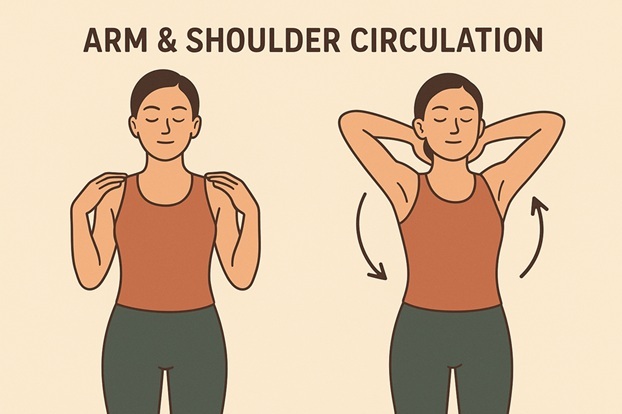
Arm & Shoulder Circulation is a gentle mobility exercise that increases blood flow, releases tension, and warms up the shoulders, arms, and upper back. It is often used as a preparatory or recovery movement in yoga to improve joint flexibility and circulation.
Description & Steps:
- Starting Position:
- Stand or sit tall with spine straight, shoulders relaxed.
- Arms relaxed by the sides.
- Hand Placement for Rotation:
- Place your palms lightly on your shoulders (fingers pointing forward).
- Elbows point outward to the sides, forming a “goalpost” shape.
- Forward Circulation (Shoulder Rolls):
- Inhale and lift elbows up toward the ceiling.
- Move elbows forward in a circular motion, making a full circle.
- Continue for 6–8 rounds.
- Backward Circulation (Reverse Shoulder Rolls):
- Inhale and lift elbows up again.
- Move elbows backward in a circular motion, completing a smooth rotation.
- Repeat 6–8 rounds.
- Arm Extension Variation:
- After rotations with palms on shoulders, extend arms straight out to the sides.
- Perform small circular motions forward and backward to increase shoulder mobility.
- Breathing:
- Coordinate each rotation with deep, smooth breaths.
- Inhale as you lift, exhale as you complete the circle.
Benefits:
- Improves shoulder, upper back, and arm mobility.
- Increases blood circulation to upper limbs and neck.
- Relieves tension, stiffness, and fatigue in shoulders and upper back.
Contraindications:
- Shoulder dislocation or recent shoulder surgery.
- Severe neck or upper back injury.
- Acute inflammation in arms, wrists, or shoulders.
Chakki Chalanasana
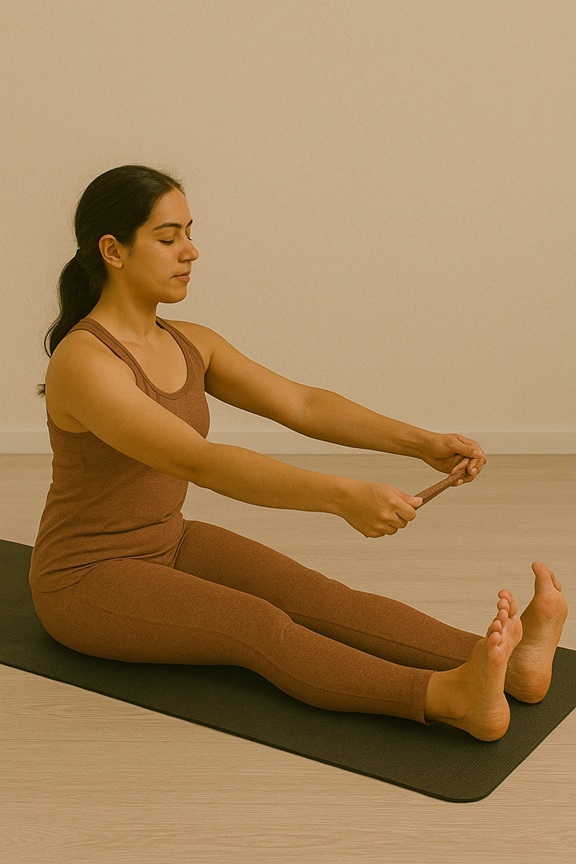
Chakki Chalanasana (Churning the Mill Pose)
About the Pose
Chakki Chalanasana is a traditional Hatha Yoga practice where the body mimics the action of grinding flour with a hand-driven millstone. It is performed in a seated position with legs stretched apart, where the arms move in a large circular motion as though rotating a millstone. This simple yet powerful movement stretches multiple muscles, tones the abdomen, and improves spinal flexibility.
It is often included in yoga for beginners, therapeutic practices, and women’s health routines.
How to Practice
- Sit on the floor with legs stretched wide apart.
- Clasp your hands together and extend arms forward.
- Imagine holding a handle of a millstone and rotate your upper body and arms in a large circle — first clockwise, then counterclockwise.
- Keep breathing naturally, synchronizing with the movement.
Benefits of Chakki Chalanasana
- Improves Digestion: Massages abdominal organs, stimulating better digestion and metabolism.
- Strengthens Core Muscles: Engages and tones abdominal and back muscles.
- Enhances Flexibility: Stretches the spine, waist, and hips, improving mobility.
- Supports Women’s Health: Often recommended for regulating menstrual cycles and easing menstrual discomfort.
- Boosts Circulation: Increases blood flow to the pelvic region and lower body.
- Stress Relief: The rhythmic, circular motion has a calming effect on the mind.
Contraindications (When to Avoid)
- Pregnancy: Not recommended after the first trimester due to pressure on the abdomen.
- Hernia or Severe Abdominal Issues: Avoid if suffering from hernia, ulcers, or recent abdominal surgery.
- Severe Back Pain or Slipped Disc: People with spinal injuries should refrain from this practice.
- High/Low Blood Pressure: Should be practiced cautiously or avoided if advised by a doctor.
- Recent Surgery: Especially abdominal or pelvic surgeries.
Pada Uttanasana (Double Leg Raise Pose)
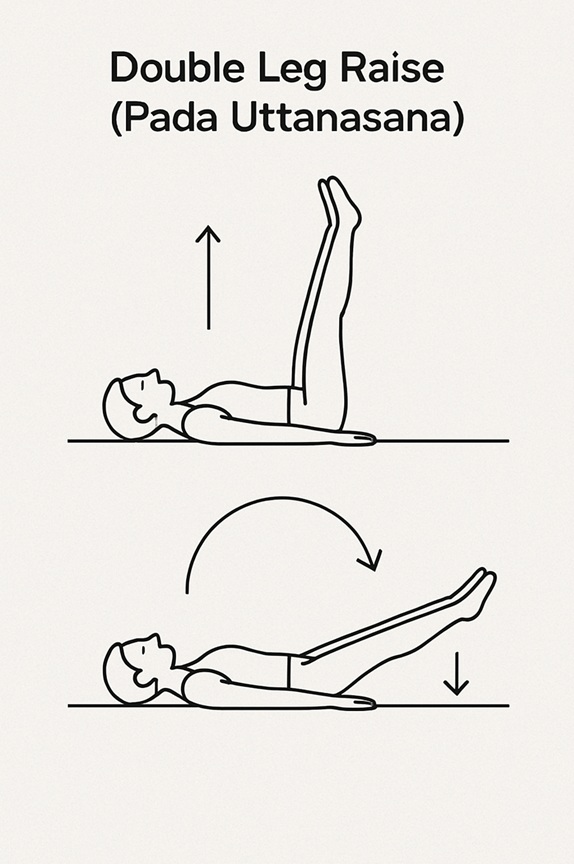
Introduction
Pada Uttanasana is a classic yogic core-strengthening posture where both legs are lifted together while lying on the back. The name comes from Sanskrit: Pada (legs), Uttana (intense stretch/raised), and Asana (pose). It is commonly practiced as part of yoga therapy for digestion, abdominal strength, and circulation.
How to Practice
- Lie flat on your back with legs together and arms alongside the body, palms facing down.
- Inhale deeply and engage the abdominal muscles.
- Slowly lift both legs upward, keeping them straight, until they form a 90° angle with the floor.
- Hold for a few breaths if comfortable, keeping the core engaged.
- Exhale and slowly lower the legs back toward the floor without dropping them abruptly.
- Repeat 3–5 rounds, gradually building endurance.
Benefits
Physical Benefits:
- Strengthens the abdominal muscles and tones the core.
- Improves digestion and reduces constipation by stimulating abdominal organs.
- Strengthens hip flexors, thighs, and lower back muscles.
- Enhances blood circulation in the pelvic region.
- Helps reduce belly fat with regular practice.
Therapeutic Benefits:
- Useful in managing mild digestive issues, sluggish metabolism, and bloating.
- Can support reproductive health by improving circulation to pelvic organs.
- Calms the nervous system when coordinated with slow breathing.
Contraindications
Avoid or practice with caution if you have:
- Severe back pain or herniated disc.
- High blood pressure or heart conditions.
- Recent abdominal surgery, hernia, or ulcers.
- Severe menstrual discomfort (practice under guidance).
- Pregnancy (not recommended).
Plank Pose (Dandasana / Kumbhakasana)
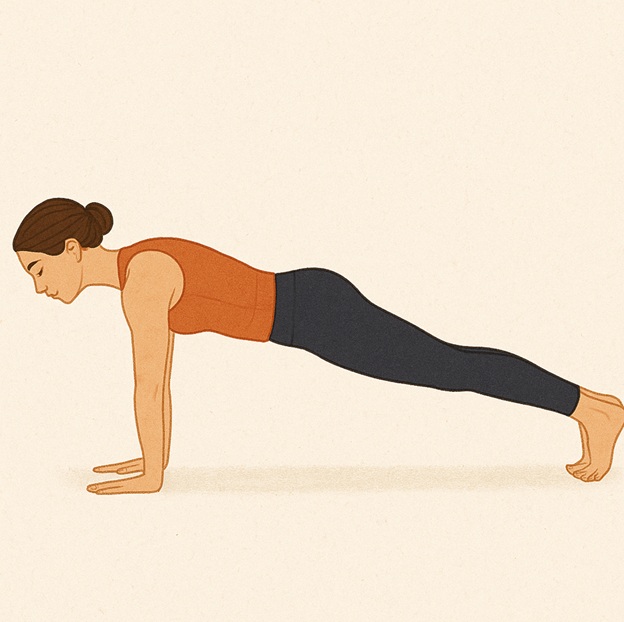
Introduction
While Dandasana in classical yoga refers to the Staff Pose (seated, legs extended forward), in modern practice the name is often used interchangeably with Plank Pose, also called Kumbhakasana. This posture is a fundamental core-strengthening asana that builds stability, stamina, and balance throughout the body.
How to Practice
- Begin in a tabletop position (hands and knees on the mat).
- Step both feet back, straightening the legs, and balance on the balls of your feet.
- Keep your wrists aligned under the shoulders, arms strong, and fingers spread wide.
- Engage the core by pulling the navel slightly inward.
- Maintain the body in a straight line from head to heels (avoid sagging or lifting the hips too high).
- Gaze slightly ahead of your fingertips.
- Hold for 20–60 seconds, breathing deeply. Gradually increase duration as strength improves.
Benefits
Physical Benefits:
- Strengthens the core, shoulders, arms, and legs.
- Improves posture and spinal stability.
- Tones abdominal and back muscles.
- Increases endurance and prepares the body for more advanced asanas.
Therapeutic Benefits:
- Supports lower back health by building a strong core.
- Enhances focus and concentration due to the balancing effort.
- Boosts metabolism and stamina.
Contraindications
Avoid or modify if you have:
- Wrist, shoulder, or elbow injuries.
- Severe lower back pain or spinal disorders.
- High blood pressure or cardiovascular strain (avoid long holds).
- Pregnancy (especially in later trimesters).
Padachalasana
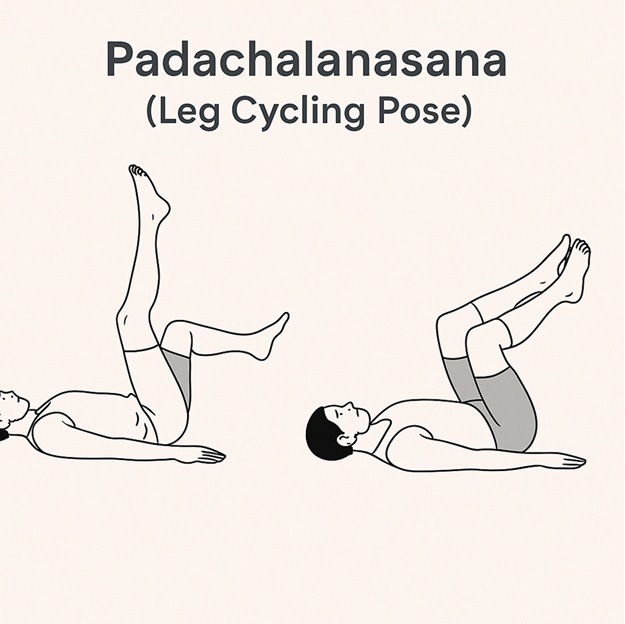
Introduction
Padachalasana (from Pada = leg, Chalana = movement) is a dynamic yoga exercise performed while lying on the back, where the legs are moved in a cycling motion. It is particularly effective for strengthening the abdominal muscles, hips, and thighs, and is commonly taught in warm-up sequences or therapeutic practices.
How to Practice
- Lie flat on your back on a yoga mat. Keep arms alongside the body, palms facing down.
- Bend one knee and bring it toward the chest.
- Extend the leg forward and upward as if pedaling a bicycle.
- Repeat the motion with alternate legs, creating a smooth cycling movement.
- Continue for 10–15 rounds forward and then 10–15 rounds backward.
- Breathe naturally throughout the practice.
Benefits
Physical Benefits:
- Strengthens abdominal and core muscles.
- Improves flexibility of the hip joints and thighs.
- Tones the leg muscles and reduces stiffness in knees and hips.
- Stimulates blood circulation in the pelvic and lower abdominal region.
- Helps in burning calories and reducing belly fat.
Therapeutic Benefits:
- Improves digestion and relieves gas, bloating, and constipation.
- Beneficial for reproductive health in both men and women.
- Helps in managing stiffness due to sedentary lifestyle.
Contraindications
Avoid or modify if you have:
- Severe lower back pain or spinal injury.
- Recent abdominal surgery, hernia, or ulcers.
- Advanced pregnancy.
- Severe arthritis in hips or knees.
